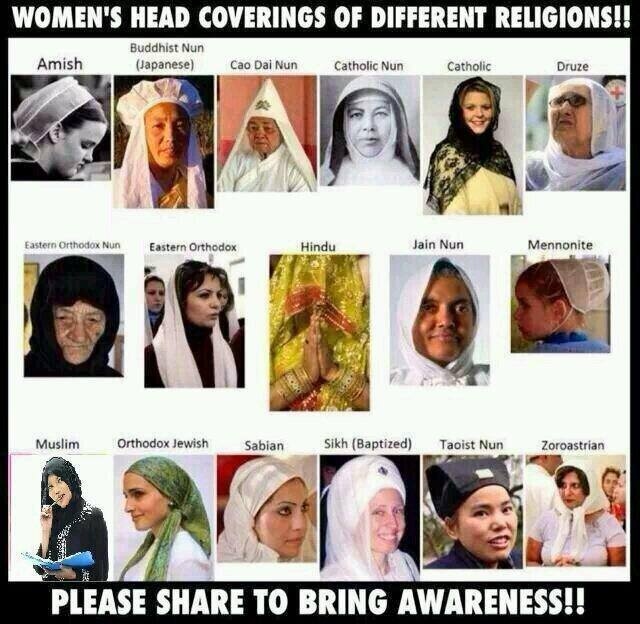Laura Morlock
My last half year or so has largely been spent preparing for PhD studies next year. By “preparing,” I mean that I had to write a tonne of scholarship and program applications, all of which required me to specify my research plans. Since my proposed dissertation is (surprise surprise) closely connected to the interests I express on this blog, I decided my research proposal might be of interest to my readers.
Now, be forewarned, it is full of academic speak, which can be a bit dry. But, it does fairly succinctly summarize what I plan to do. Since I have been accepted into my PhD program of choice (it’s a Religious Studies program) and this proposal has been initially approved, it looks like in some way or another I will get to spend the next four (or five) years studying Catholic, Mennonite and Muslim veiling practices in Canada. And yes, that does sound like getting to eat cake all day to me (without the tummy ache … although footnotes are certainly a pain in the … never mind).

So, here is my research proposal (slightly edited):
My research concentrates on interreligious encounters in North America, particularly in the experience of minority women within the framework of material culture. I examine the intersection of religious ideology, gender, culture and historic factors, and the impact these have on women’s appearance. This material evidence, integrated with oral histories and conventional academic sources, provides unique insights into the role new Canadian Muslim women who veil navigate for themselves in a society which views such customs with suspicion. In my proposed dissertation, Blinded by the Veil: Mennonite, Catholic and Muslim Responses to the Hijab, I will use these two Christian groups and how they respond to this visible Muslim practice as a case study of how North Americans encounter the reality of multiculturalism, while considering Muslim responses to these perceptions.

North American society values the separation of private convictions and public practice. In this culture, Canadians and Americans alike take pride in their tolerance of other’s beliefs. This creates tension, however, when private religious belief is demonstrated in a public way. The Muslim veil, in particular, is a source of fierce debate, extending to proposed legal banning. When Muslim women wear their hijabs or niqabs in public venues, some perceive this as a hostile practice that directly confronts “North American values,” such as equality and liberty, particularly for women. They understand the practice of veiling as a return to a framework of society their foremothers fought to move beyond. Many North Americans interpret hijab through the lens of “liberation,” where instead of promoting feminism’s true ideal (the ability to choose for oneself), “liberation” is turned into explicitly removing the veil. In this way, the veil becomes a solid onto which many North Americans project their own negative understandings of what the practice of hijab represents. In these perceptions, it is a short jump from a hair covering to male guardianship laws and female genital mutilation.
Conversely, these associations are not entirely unfounded. Groups such as the Taliban, Iranian morality police and Saudi Mutawas have used hijab as one of several methods to repress women’s rights. Tragic murders in Canada where hijab (often inaccurately) appears to be the impetus, such as Aqsa Parvez’s, spark heated debates about veiling and fears of further “honour killings” as inextricably linked with Muslim immigration. New Canadian Muslims for whom hijab is a familiar practice cannot reconcile these haram acts with their own veiling practices, and do not necessarily understand the objections Western feminist tradition motivates, are themselves blinded to what their veil has the potential to communicate. Therefore, Muslim responses to these concepts will make up a third smaller, but essential element of this study. Without engaging the internal Islamic theological debates, I will review Muslim women’s reasons for veiling, and how they use the hijab to assert their agency within both the Islamic and mainstream North American communities.

Both Mennonites and Catholics present the perspective of people with histories of veiling and that are actively engaged in building relationships with their new Muslim neighbours. Both denominations present a large spectrum of beliefs regarding headcoverings and the role of women in society. Do the dynamics of the debate as these groups moved away from veiling in any way affect the way they respond to hijab? What does covering women’s hair represent to them? Does it relate to women’s sexuality, individuality or liberty?
In this study I seek to bring forth these cultural and religious misunderstandings, and the ways in which these three groups are working to move beyond them. This will provide both a case study of how North Americans are encountering religious diversity, and specific methods groups are employing to transcend contentious differences. To accomplish this I will use a primarily material culture based methodology while incorporating a traditional academic framework, and following the examples of scholars in the field. I will utilize oral histories (in the manner of Willa K. Baum, Thomas L. Charlton, and Robert F. Harney), religious fashion and textile inquiry (such as the works by Linda B. Arthur, Emma Tarlo, Fadwa El Guindi, Heather Marie Akou and Faegheh Shirazi), and previous work on Muslim women in North America (including Sajida Sultana Alvi, Homa Hoodfar, Sheila McDonough, Katherine Bullock, and Donna Gehrke-White).








